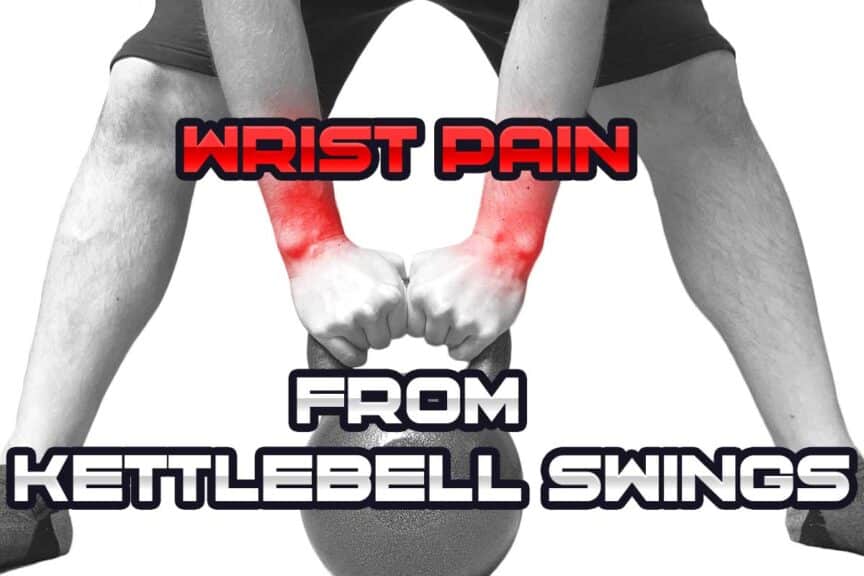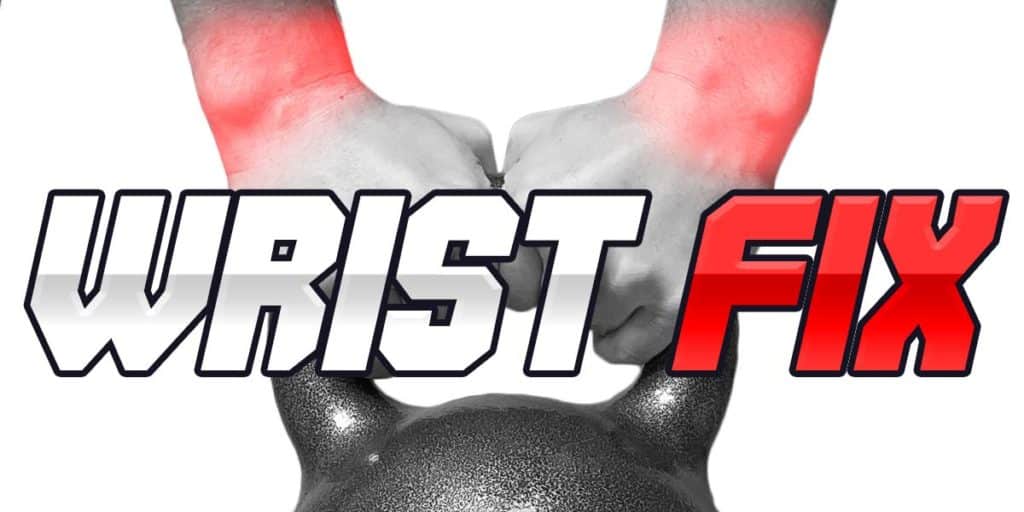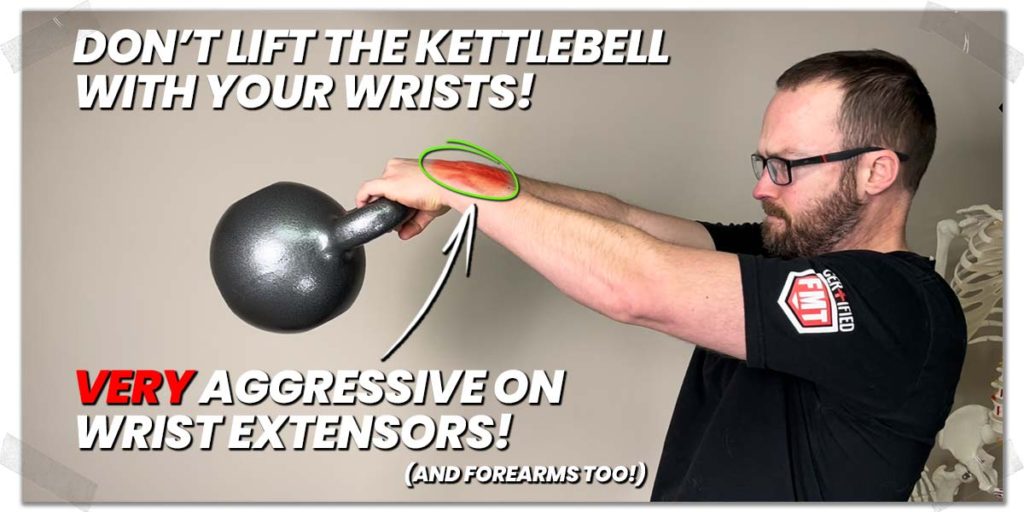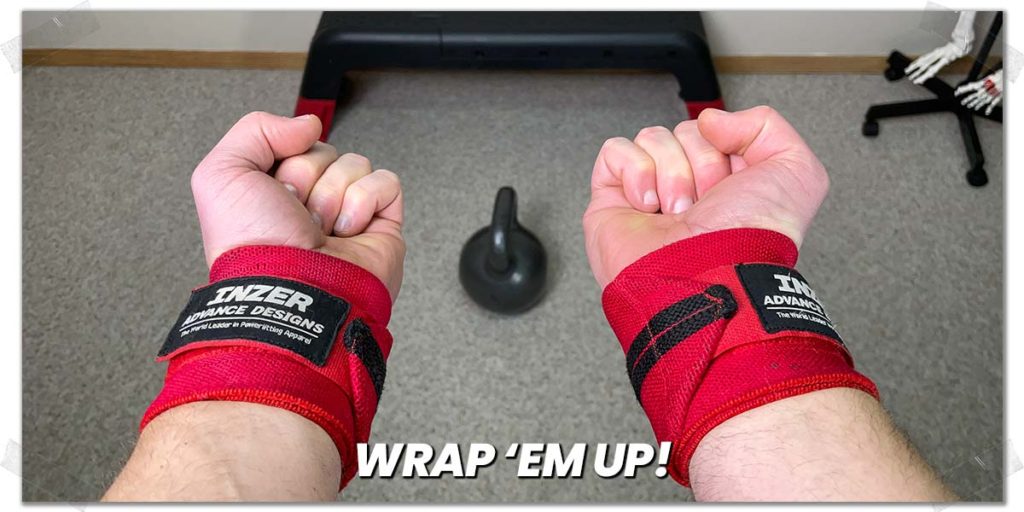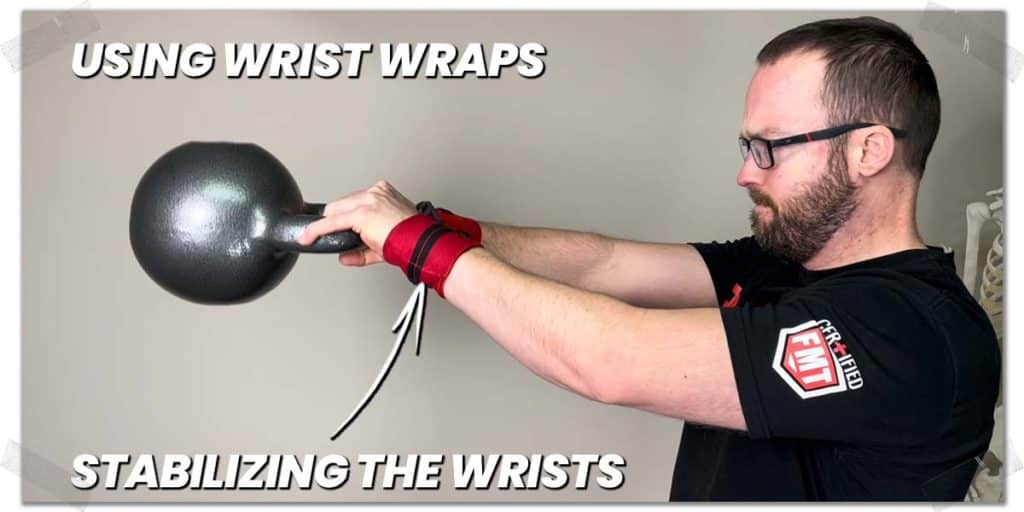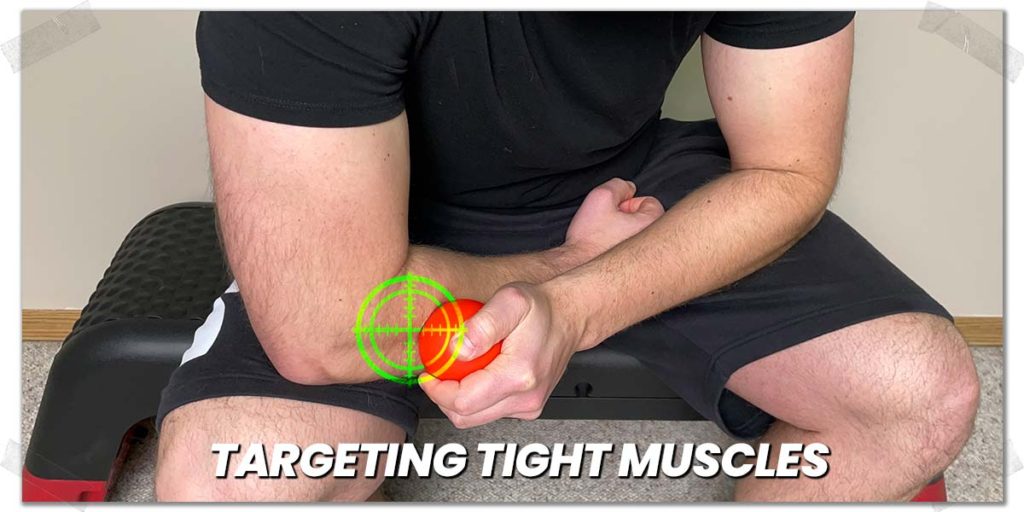While the kettlebell swing is arguably one of the greatest full-body exercises you could ever do, it shouldn’t cause any abnormal pain or discomfort. If you experience wrist pain during or after your kettlebell swings, something ain’t right, and it would likely be in your best interests to get the issue under control as quickly and effectively as possible.
Wrist pain from kettlebell swings is often the result of gripping the kettlebell too tight, moving your wrists too much throughout the movement, or having tight forearm muscles. Solutions involve optimizing your grip, movement technique and muscle health in your forearms.
Thankfully, these common faults and issues can be cleaned up quite easily when it comes to this particular issue.
So, if you want all the details, keep on reading!
ARTICLE OVERVIEW (Quick Links)
Click/tap any headline below to instantly read that section!
Issue 1: You’re not using your hips
Issue 2: Your grip is too tight
Issue 3: You’re moving your wrists too much
Issue 4: Tight forearm musculature
Related article: Pro Advice: Find The Best Physical Therapist for YOU With These Tips
Disclaimer: While I am a physical therapist, I am not YOUR physical therapist. As a result, I cannot tell you whether or not any treatments or training methodologies mentioned on this website or in this article may or may not be appropriate for you, including treatment for wrist pain. By following any information within this post, you are doing so at your own risk. You are advised to seek appropriate medical advice for any pain you may be experiencing.
Issue 1: You’re not using your hips
For many people new to the kettlebell swing, one of the most prominent reasons for their wrist pain actually comes from their hip movement — or lack thereof.
Beginners often fail to perform the kettlebell swing with proper hip drive, which is the explosive or powerful component of the movement where the hips are thrust forward, generating the kettlebell’s upwards momentum.
Related article: How Elbow Sleeves Can Help Your Tendonitis (And Which Ones to Wear)
When performing the swing, I like to tell my clients that “the arms are just coming along for the ride,” meaning that there should be no discernible lifting of the kettlebell with the arms — they’re just simply holding onto the weight.
If the arms are lifting the weight upwards, the wrist extensor muscles have to work excessively hard in order to stay in their neutral position. Having to perform this excessively strenuous demand rep after rep is a sure-fire way to generate wrist (or elbow) pain.
The solution: Make sure that the kettlebell is swinging upwards, not from pulling it upwards with your arms but from the momentum generated by your hip thrust. Kettlebell swings are meant to be an exercise that taxes the lower body muscles and the backside, not the shoulder or forearm muscles.
Issue 2: your grip is too tight
While you certainly want to have a secure grasp on the kettlebell, a death grip likely isn’t the way to go. The problem with an overly tight grip is that it can potentially strain the tendons in your wrists; when your grip clamps down on the kettlebell, it prevents your wrists from being able to move, essentially fusing your wrists and the kettlebell itself into one single unit.
While you don’t want your wrists to move too much during the swing, the tight grip means that the weight of the kettlebell will want to pull your wrist upwards or downwards, but since a tight grip prevents your wrists from moving in either direction, the result will be an excessive strain on these tendons (which are acting like brakes on a car — preventing movement), which can lead to pain.
The solution: The solution is to use a grip that is tight enough to feel secure when performing the swing but not so tight that it can’t rotate a bit within your grasp. This is especially true for the bottom phase of the swing, where the kettlebell is between your legs.
Issue 3: You’re moving your wrists too much
While having some wrist movement during the kettlebell swing is permissible, excessive or unnecessary amounts are likely only going to lead to pain. While you can likely get away with it initially, irritation or pain can develop in the wrists if you’ve performed dozens or hundreds of swings (over multiple sessions) while putting excessive movement into the wrist joint.
This technique fault tends to rear its ugly head most often at the bottom of the swing when the kettlebell is between the legs; the further back the kettlebell moves behind you, the more you’re likely to flex (bend) your wrists to follow its path. While this itself can stress the wrists, coming out of this position (upwards swing initiation) can be excessively provocative for the wrists since they must now move in the opposite direction from the kettlebell’s momentum.
The solution: Sometimes, the solution is as simple as tightening up your grip just a bit. However, if you just can’t seem to get your wrist movement under control, a wise strategy to consider would be to use wrist wraps. When wrapped with appropriate tension, a good pair of wrist wraps will immobilize your wrists to a large extent, preventing unwanted movement from occurring throughout the movement.
Issue 4: Tight forearm musculature
If your technique is on point and you know that your grip and wrist movements are adequate, it might be a good idea to examine the rest of your forearm muscles.
When tight, irritated, or otherwise unhealthy, the forearm muscles can affect their subsequent tendons, which cross the wrist joint on the front and backside. In this regard, the painful wrist is merely the victim, with the actual culprit being the muscles further up the arm. Therefore, you might experience relief or resolution of your symptoms by treating the forearm itself rather than the wrist.
The solution: There are multiple ways you can go about treating your forearm muscles if they’re tight, full of painful trigger points or just otherwise need some love and care. You can always opt for professional treatment from a qualified healthcare professional, such as a physical therapist, massage therapist, or another practitioner.
But if it’s simply a matter of your muscles being a bit tight or acutely overworked, and you’d like to treat the issue yourself, you may experience noticeable relief with any of the following techniques:
- Voodoo flossing
- IASTM
- “Tissue smash” with a lacrosse ball
- Heat
How you go about targeting and treating your forearms is up to you, but as some general rules, here’s what I would recommend:
- Start by targeting the muscles more on the gentle side and then scale things up from there. Experiencing a mild soreness the next day is usually perfectly acceptable, provided it’s only mild and doesn’t last longer than approximately 24 hours.
- Assuming the tightness has been more of an ongoing issue (i.e. it’s been around for a week or longer), opting for heat will likely produce better physiologic responses for pain and tissue recovery than ice likely will. However, this isn’t set in stone, so if you prefer ice, you can still give that a go instead (I just wouldn’t personally recommend it).
- Get in the habit of doing soft tissue work to your forearm muscles on a regular basis; this won’t be an overnight change. It will likely take repeated bouts of massaging or mobilizing the muscles and tendons. Still, as time goes on, you’ll hopefully be able to space out these self-treatment sessions so that they’re fewer and further between.
As well, making sure you warm up the area a few minutes before your kettlebell swings or workout is likely a smart move to make; it will help to ensure the muscles and tendons are better prepared for the demands they’re about to undergo.
Final thoughts
The kettlebell swing is one of the most effective full-body exercises that can be done (just ask any strength and conditioning specialist). Therefore, you’ll want to be able to perform this exercise for all your days ahead. This means getting your wrist pain (or any other pain) that occurs with your kettlebell swings under control in a timely fashion. Give the tips in this article a shot (if appropriate for you) so that you can keep on swingin’ for all your days ahead!

Hi! I’m Jim Wittstrom, PT, DPT, CSCS, Pn1.
I am a physical therapist who is passionate about all things pertaining to strength & conditioning, human movement, injury prevention and rehabilitation. I created StrengthResurgence.com in order to help others become stronger and healthier. I also love helping aspiring students and therapists fulfill their dreams of becoming successful in school and within their clinical PT practice. Thanks for checking out my site!

